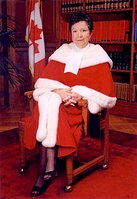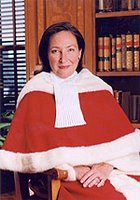

In my post on New Year’s Day I chose to share with the Liblogs and Progressive Blogger communities confidential data just released that in essence shows a judicial bias at the Ontario Court of Appeal. The post generated allot of hits, some exceptional enthusiasm, some comments, some skepticism, and some indifference.
I especially appreciated those wanting to know more details, such as Canadian Tar Heel, Anonymous Gayle and Devin. Gayle and Devin concluded with the information I had provided that the study was “flawed”. We had it out a little bit in the comments section of the post. In the end I disagree with what I consider to have been pre-mature conclusions. Nevertheless, we can agree to disagree, which is perfectly fair. Healthy skepticism keeps the world moving. It would be good to know if after this post we still disagree.
As for the very skeptical and borderline belligerent, “decoin”, there is a case at the Court of Appeal today that is using this report as evidence.
I may have been short-sighted in identifying as an example only Supreme Court Justice Rosalie Abella’s discrimination rating. Another former Ontario Court of Appeal Justice with almost as bad a discrimination rating was appointed by then Justice Minister, Irwin Cottler, to the Supreme Court of Canada on the same day in 2004 as Justice Abella.
If you refer back to the results that I posted on January 1, Justice Charron was not far behind Justice Abella on the gender report's discrimination rating. Justice Charron favoured women over men 62.6% of the time, which is considered “heavy discrimination also. Her results in brief are as follows:
For Charron JA D = 70.0 - 7.4 = 62.6 % (heavy)
Wikipedia has this to say about Justice Charron:
Charron (born March 2, 1951 in Sturgeon Falls, Ontario) is a Canadian jurist. She as appointed to the Supreme Court of Canada in October, 2004, and is the first native-born Franco-Ontarian Supreme Court judge. (This distinction has sometimes been ttributed to Louise Arbour, but Arbour was born and raised Québécoise.)
Charron received a Bachelor of Arts degree from Carleton University in 1972, her Bachelor of Law degree from the University of Ottawa in 1975, and was called to the Bar of Ontario in 1977. She practiced civil litigation, and then joined the Crown Attorney's office in 1980, and then became a law professor at the University of Ottawa. She was appointed to the district Court of Ontario in 1988, and to the Ontario Court of Appeal in 1995. She is eligible to sit on the bench until 2026 when she reaches age 75.
I am sensitive that interested bloggers may like more information on how to define a win, the difference between pure wins and partial wins, and the number of men versus women who made these appeals. The following is an extraction from another report called “Judicial Bias at the Court of Appeal I”, which used “quick law” to consider the cases that were before Justice Abella and Justice Charron over time.
"For Justice Abella the total cases can be summarized as follows:Please let me know if more information is required to show the legitimacy of this research at this time. Otherwise, I would like to know whether there is an interest, or just apathy in looking further as to whether our judiciary is upholding its Charter obligations with respect to gender neutrality or not.
Appellant, Number, Win All, Lose All, Win/Lose Some
Male, 28, 2, 23, 3
Female,13, 10, 2, 1
It can be concluded a man had a 82.1 % chance of losing on all issues, but a woman had a 84.6 % chance of winning on at least some issues when appearing before a panel with Justice Abella on it
For Justice Charron the total cases can be summarized as follows:
Appellant, Number, Win All, Lose All, Win/Lose Some
Male, 27, 3, 22, 2
Female, 10, 7, 2, 1
It can be concluded a man had a 81.5 % chance of losing on all issues, but a woman had a 80.0 % chance of winning on at least some issues when appearing before a panel with Justice Charron on it"




